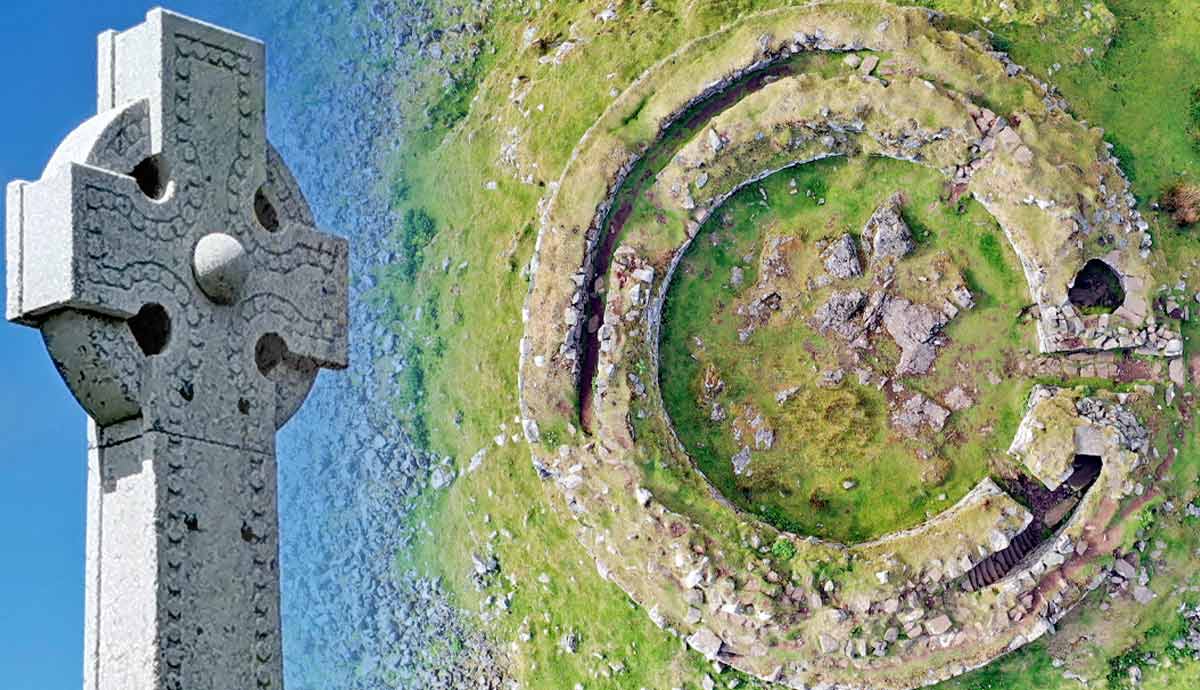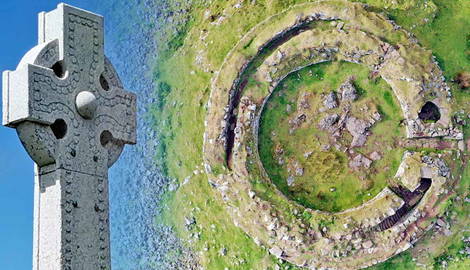
The Isle of Skye, the largest island of the Inner Hebrides of Scotland. It has a population of around 10,000 people and is only 50 miles long. Yet, it is filled with history, from prehistoric fossils to highland castles. Peppered with ruins and riveting history, here are the top seven historical places to visit on the island. If you make the drive up from Edinburgh or Glasgow, don’t miss these historic stops along the way.

1. Learn About Clan MacDonald at Armadale Castle

This ruined country house is situated on a 20,000-acre estate, in the south of the Isle of Skye, looking over a narrow sea channel called the Sound of Sleat. Clan MacDonald occupied castles and properties close to Armadale in Dunscaith and Knock before taking up residence in Armadale in 1650. A white mansion house was built in 1790. Later in 1815, a square building, designed by Edinburgh architect James Gillespie Graham, was added to the original construction. The Tudor-Gothic type castle was built more for show than for defensive purposes.

A fire ripped through the house in 1855, and the damaged area was replaced by a new wing. By 1925, Clan MacDonald abandoned the property, and the place fell into ruin. After 50 years of wind and rain, it was purchased in 1972 by the Clan Donald Lands Trust. They made the painful decision in 1981 to demolish the west part of the Castle, which was derelict beyond repair.
Current works are underway in the hope that the structure can be stabilized so that visitors may eventually enter the building. The Castle sits among 40 acres of gardens, which now receive regular maintenance and are home to several microclimates promoting exotic plant varieties and trees. The museum and gardens are open year-round.
2. Gaze Upon the Ruins of Cill Chriosd Church

Cill Chriosd Church is a ruined parish church situated in the parish of Strath. Known locally as “Kilchrist” or “Cill Chriosd,” the ruined church no longer has its roof, but its walls, first erected in the 16th century, are largely intact.
The parish of Strath includes villages of Boreraig and Susinish that were cleared during the Highland Clearances, also known as the “eviction of the Gaels.” This was a strategic eviction that took place between 1750 and 1860. The first stage was driven by landlords wishing to improve their agricultural prospects and consequently their income. Displaced tenants lost their status as crofters and became farmers or were shipped off to other industries such as quarrying, fishing, or the kelp (seaweed) industry.

The second stage of the clearance process resulted from the impact of the first. Crofting communities had become overcrowded and their lifestyles were no longer self-sustainable. Industries were collapsing and famine became widespread.
The village of Boreraig was cleared in 1853, and by then, Cill Chriosd had been replaced by the Broadford Parish Church. Although Cill Chriosd has stood since the 16th century, it is believed that it replaced an earlier building erected in medieval times. Today, it is possible to ascend the mound on which Cill Chriosd stands and read the inscriptions on the gravestones within the graveyard and enclosed burial grounds.
3. Tread the Beaches of Staffin Where Dinosaurs Once Walked

Although the Isle of Skye holds very few fossils, there is one stretch of coastline where, in 1976, teenager Dugald Ross stumbled across signs of dinosaur tracks. Since that discovery, several species have been found.
Today, you can walk the beaches at An Corran to seek out the tracks yourself. An Corran Beach is also home to a Mesolithic (Middle Stone Age) hunter-gatherer site. It is one of the oldest archaeological sites in Scotland, dating to the 7th millennium BCE.

South of An Corran beach is the Staffin Dinosaur Museum, which tells the story of Dugald Ross’s discoveries of Stegosaurus, Megalosaurus, Cetiosaurus, Hadrosaurus, and Coelophysis. Set in a small stone building, the museum contains details of the nearby archaeological excavations and items found. It is open from April through October.
4. Visit Flora MacDonald’s Grave at Kilmuir Graveyard

The famous Flora MacDonald was interred in Kilmuir Cemetery at the end of the 18th century. Born in 1722 on the island, Flora’s life changed when, in 1746, she was visiting the island of Benbecula and met Bonnie Prince Charlie, a pretender to the throne who led the failed Jacobite rising of 1745. Flora met Charles as he was hiding on Benbecula and helped him make the journey to the Isle of Skye using the alias “Betty Burke,” the name of her maid. Flora, like many other Highlanders, never turned him in, despite a £30,000 reward (equivalent to £3.5 million today).
Charles left for the mainland and Flora never saw him again. However, two weeks later, she was arrested for aiding his escape and locked in the Tower of London. She was released a year later, following the 1747 Act of Indemnity.

Flora would go on to marry Allan MacDonald in 1750 and emigrate with him to North Carolina in 1774, joining other Clan MacDonald emigrants. In 1775, the American Revolutionary War began, and Flora’s husband rallied 1,000 men in the Anson Battalion of the Loyalist North Carolina Militia, including their two sons, James and Alexander. In 1776, Flora addressed the Anson battalion in her native Gaelic tongue, a Scottish tradition of incitement to battle called “brosnachadh-catha”.
Following Flora’s riling speech, the battalion was ambushed and Flora’s husband captured and imprisoned. In 1777, the North Carolina Provincial Congress confiscated all Loyalist-owned property, leaving Flora with nothing. She moved with her family to Nova Scotia, where her husband was posted upon his release. She then returned to the Isle of Skye in 1780, where she died ten years later and was buried at Kilmuir Graveyard. Poet and essayist Samuel Johnson wrote her memorial inscription, which states: “a name that will be mentioned in history, and if courage and fidelity </em>be virtues, mentioned with honour.”
5. Discover an Ancient Burial Ground at St Columba’s Isle

The remnants of the Cathedral Church of the Bishop of the Isles from 1079 to 1498 are engulfed in thick green grasses and hidden along the banks of the River Snizort, which wraps its way around the small isle of Columba. Along with Skye residents, there are 28 chiefs of Clan MacNicol or Nicolsons buried in the holy grounds of the island. Named after Saint Columba, who, according to tradition, had preached from a nearby rock, the sacred burial grounds are thought to have a history that traces back to the pagan era.
Columba’s Isle held a prominent role in the history of the Diocese of Sodor and once houed both a cathedral and an abbey. Archaeological evidence and historical records show that the church had an 80-foot transept, constructed in the style of the Iona Abbey. Between 1079 and 1498, the cathedral church was perhaps the most important religious building in all of Scotland.
Today, it’s possible to walk along the river banks and visit the mortuary chapel on the island known as “Aite Adhlaic Mhic Neacail” meaning “MacNicol or Nicolson’s Aisle.” There are various gravestones and effigies laid among the grass that give small snapshots into the centuries of history tied to the place.
6. Walk Within the Walls of Dun Beag Broch

Dun Beag Broch at Struan is an Iron Age broch, also known as “Dun Beg.” Brochs are hollow-walled circular structures, native to Scotland and categorized as a type of complex roundhouse. Broch stems from the word “brough” which means fort, and 571 survive across Scotland.
The remnants of Dun Beag include a drystone tower protruding from the ground at around two meters (six feet) in height. The base of the walls is around four meters (thirteen feet) thick, and the internal space is eleven meters (36 feet) in diameter. When visited by Welsh naturalist and writer Thomas Pennant in 1772, the walls were believed to be four meters high (thirteen feet). Internally, there are three separate openings leading to a chamber, a stone staircase, and a narrow gallery within the wall.

An excavation between 1914 and 1920 uncovered objects made of bronze, gold, antler, pottery, iron, glass, bone, and lead. Some of these items were formed into items and utensils, such as a gold ring. Additionally, coins of kings Henry II, Edward I, James VI, George II, and George III were found during the excavation, suggesting that the broch was in use from as early as the 12th century until quite recently. Overlooking the Cuillin Hills and Loch Bracadale and sitting upon a rocky knoll, the broch is accessible on foot and open year-round.
7. Tour Dunvegan Castle and Gardens

“Caisteal Dhùn Bheagain” stands proudly over Loch Dunvegan. It is home to the Chief of Clan MacLeod. Erected first in the 13th century and then restyled into a medieval-style castle in the 19th century, the castle sits on a rock 50 feet above sea level.
The castle sits on the 40,000-acre estate belonging to the Clan MacLeod. The estate includes the Cullin mountains, fairy pools, and Dunvegan pier. The MacLeod family is one of the oldest families on the Isle of Skye, with a history that traces back to 1265. Olaf the Black, the last of the Norse kings of Man, died that year, and his younger son Leod inherited the islands of Harris and Lewis, as well as several areas upon the Isle of Skye.

The castle offers a fascinating insight into the MacLeod family history. Some of the heirlooms kept at the castle include: Sir Rory Mor’s Horn, a drinking horn belonging to a previous chief; the Fairy Flag, a tattered flag thought to have magical properties and be associated with Celtic fairies; and the small, ceremonial, wooden Dunvegan cup.
The castle is a Grade A, listed building and has received substantial amounts of money to fund its ongoing repairs, maintenance, and restoration. The castle and gardens are open daily between April and October.









